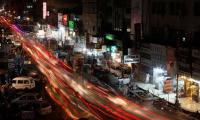In Pakistan, there are not many writers who write about history in Urdu or any other regional language, with an independent and objective lens. But there are certain writers who excel in this craft.
Dr Shah Muhammad Marri has single-handedly done the work that even institutions cannot manage to accomplish in decades. Dr Marri has over 100 books in the Balochi language to his credit, through which he has chronicled the history of Balochistan. He has also written a series of books about significant fighters for democracy in the country.
In Saraiki, more writers have written fiction than history, but even that fiction is a useful tool to understand the oppression the Saraiki people have endured for centuries. Writers such as Hafeez Khan, Nazeer Leghari, Rana Mahboob Akhtar, and Rafat Abbas have contributed greatly to Saraiki language and literature in the 21st century.
In Sindhi language a prominent name is Naseer Memon whose latest book ‘Bartanvi Raaj Mein Punjab Ji Taraqqi’ (Punjab’s Development under the British Raj) is an impressive piece of research.
But before discussing the significance of this book, a word is in order about some of his earlier contributions in Sindhi and English languages. He has nearly two dozen books to his credit dealing with various aspects of development challenges in the country especially in Sindh.
For example, his English book ‘Discriminatory Development Paradigm of Pakistan’ has seen multiple editions since it was first published in 2011. In this 240-page book, he has devoted the first part to the political and socio-economic development of the country; the second part discusses water and environmental issues ranging from climate change and glacial melt to the causes of floods and the impact of large dams.
In 2012, his Sindhi book ‘Badaljander Dour Mein Sindh’ (Sindh in a Changing World) was published. In this book, Naseer Memon mostly deals with the changing economic and political dynamics of Sindh under the PPP rule from 2008. He also debates topics such as the significance of Karachi for Sindh and for the rest of the country and how urban development needs a more circumspect approach.
From 2017 onwards, Naseer Memon has mostly focused on history writing. His book ‘Harhonki Sindh ji Tareekh’ (History of Today’s Sindh) published in 2017 deals with the post-independence economic and political developments of Sindh. He begins with the conflict of the central government with the provinces right after Partition.
In his opinion, the rigid attitude of the centre resulted in the emergence of nationalistic feelings across the country. The One-Unit scheme further aggravated the situation as all the provinces were dissolved to create a new West Pakistan province with its capital in Lahore.
His next book ‘Sindh Sochey Thi’ (Sindh is Thinking) came out in 2021, and carries the discussion forward about the strategies needed for Sindh’s economic, political, and social development. He suggests that a new thinking pattern is needed for Sindh to get out of its governance crisis. The book points out that as industries in Sindh faced a declining trend and hardly any new industrial units were set up in the three successive provincial governments run by the PPP, both rural and urban people in the province faced economic hardships.
In 2023, Naseer Memon published a book in Sindhi, ‘Pakistan ji Siyasi Tareekh: 1947-2013’ (Political History of Pakistan from 1947 to 2013). In this book, he goes much beyond Sindh and discusses the overall emerging scenario in the new country that needed a more powerful parliament than a powerful governor-general.
He argues that the trend of dismissing provincial governments in quick succession became a root cause of discontent in nearly all provinces. He particularly targets the so-called ‘Objectives Resolution’ that adversely impacted constitutional development in the country with a clearly religious tinge.
Finally coming to his latest Sindhi book ‘Bartanvi Raaj Mein Punjab ji Taraqqi’, we see a more insightful approach to history writing. The book draws from original sources of Mughal history discussing how Punjab shaped its administrative and military structure from the 16th century onwards. Then he moves on to discuss the beginning of the British period in which a more modern military structure was set up.
He has consulted numerous books, documents and research journals for his analysis of Punjab under the British Raj. He explains that till 1857, Punjab did not have a dominant position in the British army.
Before the War of Independence in 1857, Bengal was the central pivot on which the British army mostly relied. When the revolt reached Bengal, its ferocity there shocked British rulers who then decided to recruit more Punjabi soldiers, expecting them to be more pliant and obedient.
Gradually, the British had a more favourable tilt towards soldiers from Punjab while Bengal became an unfavourable spot for British rulers who reduced their recruitment from the eastern parts of India and hired more from the western and north-western parts of British India.
By the turn of the 20th century, the recruitment of soldiers from Bengal had almost stopped. That was a major reason for the underwhelming presence of Bengalis in the army of Pakistan after independence. Punjabis and Pakhtuns had more than their due share in the military which also started looking at Bengalis with suspicion when they demanded democracy. This suspicion was a legacy of the British who handed it over to the new ‘brown’ rulers. The book discusses the role World War I played in increasing the dominance of Punjab in the military.
The concept of ‘martial races’ was a misplaced theory that turned certain communities more belligerent and boosted their ego as ‘braver’ and more ‘courageous’ than others. The martial race theory was nothing but an attempt to inculcate an overblown pride to prove them as fighters par excellence. This made it seem that other nationalities were not as brave or courageous as certain martial races from the north and north-west of India and later from Pakistan. Perhaps that was the reason why provincial governments emerged as untrustworthy and liable to be dismissed at will.
Gradually, in almost all organs of the state the so-called ‘martial races’ started occupying prominent positions in the civil and military bureaucracy, a practice that greatly harmed national unity in the country. The book also deals with the role feudal lords and religious leaders have played in strengthening ‘martial races’ and their dominance in the country.
The British scheme of establishing new colonies and awarding them to the ‘martial races’ created a new agricultural structure that ignored or overlooked other nationalities such as the Baloch and Sindhis. Barrage colonies after independence continued with the same trend.
After the implementation of One Unit, most appointments and postings originated from Lahore for the rest of West Pakistan. Migrants from India – Mohajirs – who had a major share in the early civil bureaucracy of Pakistan gradually lost their dominance as ‘martial races’ from the country’s north and north-west prevailed.
According to the statistics that Naseer Memon has given in his book, in 1947 nearly 75 per cent of administrative staff came from Punjab and UP (Uttar Pradesh).
The last two chapters of the book are highly informative as they deal with the landed families of southern Punjab too that served British masters. It will be worthwhile to translate this book into Urdu; there are already many books available on similar topics in English.
The writer holds a PhD from the University of Birmingham, UK. He tweets/posts @NaazirMahmood and can be reached at: mnazir1964@yahoo.co.uk
Studies have established that most effective interventions for improving quality of education is to train teachers
For Pakistan, 2025 must be year of decisive action and vision
Mpox is caused by monkeypox virus which belongs to family of viruses that includes smallpox virus as well
This digital shift represents profound change, but it also brings with it significant challenges
Benazir Bhutto, like Indra Gandhi in neighbouring India, did not have to start from scratch
Workplace therapy has tangible benefits like improving mental well-being as well as productivity







